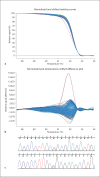A Hypomorphic Allele in the FGF8 Gene Contributes to Holoprosencephaly and Is Allelic to Gonadotropin-Releasing Hormone Deficiency in Humans
- PMID: 21045958
- PMCID: PMC2941840
- DOI: 10.1159/000302285
A Hypomorphic Allele in the FGF8 Gene Contributes to Holoprosencephaly and Is Allelic to Gonadotropin-Releasing Hormone Deficiency in Humans
Abstract
Holoprosencephaly (HPE), the most common malformation of the human forebrain, may arise due to interacting genetic and environmental factors. To date, at least 12 contributory genes have been identified. Fibroblast growth factor 8 (Fgf8) belongs to the FGF family of genes expressed in several developmental signaling centers, including the anterior neural ridge, which is implicated in midline anomalies in mice. In humans, FGF8 mutations have been previously reported in facial clefting and in hypogonadotropic hypogonadism, but have not been reported in patients with HPE. We screened 360 probands with HPE for sequence variations in FGF8 using High Resolution DNA Melting (HRM) and sequenced all identified variations. Here we describe a total of 8 sequence variations in HPE patients, including a putative loss-of-function mutation in 3 members of a family with variable forms of classic HPE, and relate these findings to the phenotypes seen in other conditions.
Figures


References
-
- Brown SA, Warburton D, Brown LY, Yu C, Roeder ER, et al. Holoprosencephaly due to mutations in ZIC2, a homologue of drosophila odd-paired. Nat Genet. 1998;20:180–183. - PubMed
-
- Cohen M. Holoprosencephaly: Clinical, anatomic, and molecular dimensions. Birth Defects Res A Clin Mol Teratol. 2006;76:658–673. - PubMed
LinkOut - more resources
Full Text Sources

